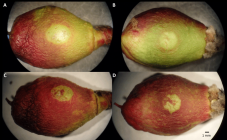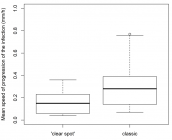Abstract
Research Article
Genetic variability in the susceptibility of immature peach fruit to Monilinia laxa is associated with surface conductance but not stomatal density
Leandro Oliveira Lino, Carole Confolent, Véronique Signoret, Michel Génard and Bénédicte Quilot-Turion*
Published: 25 August, 2022 | Volume 6 - Issue 3 | Pages: 091-100
Monilinia laxa is a fungus that causes brown rot in stone fruit. Immature green fruits in the first stage of fruit development (stage I) are generally susceptible. To investigate the relationship between the physical characteristics of immature fruit and susceptibility to M. laxa, we characterized the progeny, derived from a clone of wild peach (Prunus davidiana) crossed with two commercial nectarines (Prunus persica) varieties, through laboratory infection, transpiration monitoring and stomata counting. Two types of fruit infections were observed - ‘classic’ brown rot and ‘clear spot’ symptoms - which have not previously been described in the literature. The number and density of stomata did not explain the observed variability of infection in the progeny. However, surface conductance was positively correlated with infection level. This study provides experimental evidence partially linking physical fruit characteristics to brown rot infection at the immature fruit stage. The role of delayed cuticle deposition in susceptibility to brown rot of immature fruit is discussed.
Read Full Article HTML DOI: 10.29328/journal.jpsp.1001081 Cite this Article Read Full Article PDF
Keywords:
Prunus persica; Brown rot; Fungal disease resistance; Stomata number
References
- Martin LB, Rose JK. There's more than one way to skin a fruit: formation and functions of fruit cuticles. J Exp Bot. 2014 Aug;65(16):4639-51. doi: 10.1093/jxb/eru301. Epub 2014 Jul 15. PMID: 25028557.
- Serrano M, Coluccia F, Torres M, L'Haridon F, Métraux JP. The cuticle and plant defense to pathogens. Front Plant Sci. 2014 Jun 13;5:274. doi: 10.3389/fpls.2014.00274. PMID: 24982666; PMCID: PMC4056637.
- Oliveira Lino L, Pacheco I, Mercier V, Faoro F, Bassi D, Bornard I, Quilot-Turion B. Brown Rot Strikes Prunus Fruit: An Ancient Fight Almost Always Lost. J Agric Food Chem. 2016 May 25;64(20):4029-47. doi: 10.1021/acs.jafc.6b00104. Epub 2016 May 10. PMID: 27133976.
- Pascal T, Levigneron A, Kervella J, Nguyen-The C. Evaluation of two screening methods for resistance of apricot, plum and peach to Monilinia laxa. Euphytica. 1994;77(1–2):19–23.
- Børve J, Sekse L, Stensvand A. Cuticular Fractures Promote Postharvest Fruit Rot in Sweet Cherries. Plant Dis. 2000 Nov;84(11):1180-1184. doi: 10.1094/PDIS.2000.84.11.1180. PMID: 30832164.
- Nguyen-The C, Hugueney R, Arnoux M. Contribution to the study of the penetration mechanisms of 2 fungal parasites of nectarines: Monilia laxa and Rhizopus stolonifer. Agronomie. 1989; 9:271.
- Byrde RJW, Willetts HL. Brown Rot Fungi of Fruit: Their Biology and Control. Pergamon. Oxford, UK; 1977; 171.
- Wade GC, Cruickshank RH. The Establishment and Structure of Latent Infections with Monilinia fructicola on Apricots. J Phytopathol. 1992; 136:12.
- Blanke MM, Lenz F. Fruit photosynthesis. Plant, Cell Environ. 1989; 12:31-46.
- Pillitteri LJ, Torii KU. Mechanisms of stomatal development. Annu Rev Plant Biol. 2012;63:591-614. doi: 10.1146/annurev-arplant-042811-105451. Epub 2012 Jan 30. PMID: 22404473.
- Roth I. Fruits of Angiosperms . G. Borntra. Berlin: Encyclopedia of Plant Anatomy, Band X Teil 1; 1977. 675.
- Gibert C, Chadœuf J, Vercambre G, Génard M, Lescourret F. Cuticular cracking on nectarine fruit surface: spatial distribution and development in relation to irrigation and thinning. J Am Soc Hortic Sci. 2007; 132(5):583-591.
- Becker T, Knoche M. Deposition, strain, and microcracking of the cuticle in developing ‘Riesling’ grape berries. Vitis. 2012; 51:1-69.
- Knoche M, Peschel S, Hinz M, Bukovac MJ. Studies on water transport through the sweet cherry fruit surface: characterizing conductance of the cuticular membrane using pericarp segments. Planta. 2000 Dec;212(1):127-35. doi: 10.1007/s004250000404. PMID: 11219577.
- Knoche M, Peschel S. Deposition and Strain of the Cuticle of Developing European Plum Fruit. J Am Soc Hortic Sci. 2007; 132(5):597–602.
- Oliveira Lino L, Quilot-Turion B, Dufour C, Corre MN, Lessire R, Génard M, Poëssel JL. Cuticular waxes of nectarines during fruit development in relation to surface conductance and susceptibility to Monilinia laxa. J Exp Bot. 2020 Sep 19;71(18):5521-5537. doi: 10.1093/jxb/eraa284. PMID: 32556164; PMCID: PMC7501825.
- Mari M, Casalini L, Baraldi E, Bertolini P, Pratella GC. Susceptibility of apricot and peach fruit to Monilinia laxa during phenological stages. Postharvest Biol Technol. 2003; 30(1):105–9.
- Pascal T, Kervella J, Pfeiffer F, Sauge MH, Esmenjaud D. Evaluation of the interspecific progeny Prunus persica cv. Summer grand x Prunus davidiana for disease resistance and some agronomic features. Acta Hortic. 1998; 465(1):185-192.
- Gibert C, Lescourret F, Génard M, Vercambre G, Pérez Pastor A. Modelling the effect of fruit growth on surface conductance to water vapour diffusion. Ann Bot. 2005 Mar;95(4):673-83. doi: 10.1093/aob/mci067. Epub 2005 Jan 17. PMID: 15655107; PMCID: PMC4246857.
- Fishman S, Génard M. A biophysical model of fruit growth : simulation of seasonal and diurnal dynamics of mass. Plant, Cell Environ. 1998; 21:739-752.
- Team RC. R: A language and environment for statistical computing. R Foundation for Statistical Computing, Vienna, Austria. ISBN 3-900051-07-0. http://www.R-project.org/. 2012.
- Blanke MM. Photosynthesis of avocado fruit. Proc Second World Avocado Congr. 1992; 179-189.
- Yamaguchi M, Haji T, Yaegaki H. Relationship between fruit cracking and varietal differences of exocarp cell length and stomatal density of nectarine cultivars. Bull Natl Inst Fruit Tree Sci. 2003; 2:77–84.
- Blanke MM, Bower JP. Possible role of stomata in transpiration of avocado fruit. Acta Hortic. 1990; 275:449–50.
- Hieke S, Menzel CM, Lüdders P. Effects of leaf, shoot and fruit development on photosynthesis of lychee trees (Litchi chinensis). Tree Physiol. 2002 Sep;22(13):955-61. doi: 10.1093/treephys/22.13.955. PMID: 12204852.
- Johnson BE, Brun WA. Stomatal density and responsiveness of banana fruit stomates. Plant Physiol. 1966 Jan;41(1):99-101. doi: 10.1104/pp.41.1.99. PMID: 16656239; PMCID: PMC1086303.
- Konarska A. Micromorphological, anatomical and ultrastructural analyses of ovaries and fruitlets indicate early qualitative differences in two Prunus domestica cultivars. Sci Hortic (Amsterdam). 2015; 189:112–21.
- Peschel S, Beyer M, Knoche M. Surface characteristics of sweet cherry fruit: stomata-number, distribution, functionality and surface wetting. Sci Hortic (Amsterdam). 2003;97(3–4):265–78.
- Gibert C, Genard M, Vercambre G, Lescourret F. Quantification and modeling of the stomatal, cuticular and crack components of peach fruit surface conductance. Funct Plant Biol. 2010; 37(3):264.
- Biggs A, Northover J. Early and Late-Season Susceptibility in Peach Fruits to Monilinia fructicola. Plant Dis. 1988; 72:1070-1074.
- Lee MH, Bostock RM. Induction, Regulation, and Role in Pathogenesis of Appressoria in Monilinia fructicola. Phytopathology. 2006 Oct;96(10):1072-80. doi: 10.1094/PHYTO-96-1072. PMID: 18943495.
Figures:

Figure 1

Figure 2

Figure 3

Figure 4

Figure 5

Figure 6

Figure 7

Figure 8

Figure 9
Similar Articles
-
Non-chemical control of Armillaria mellea infection of Prunus persicaJim Downer*,Ben Faber. Non-chemical control of Armillaria mellea infection of Prunus persica. . 2019 doi: 10.29328/journal.jpsp.1001031; 3: 050-055
-
Genetic variability in the susceptibility of immature peach fruit to Monilinia laxa is associated with surface conductance but not stomatal densityLeandro Oliveira Lino,Carole Confolent,Véronique Signoret,Michel Génard,Bénédicte Quilot-Turion*. Genetic variability in the susceptibility of immature peach fruit to Monilinia laxa is associated with surface conductance but not stomatal density. . 2022 doi: 10.29328/journal.jpsp.1001081; 6: 091-100
Recently Viewed
-
Drug Rehabilitation Centre-based Survey on Drug Dependence in District Shimla Himachal PradeshKanishka Saini,Palak Sharma,Bhawna Sharma*,Atul Kumar Dubey,Muskan Bhatnoo,Prajkta Thakur,Vanshika Chandel,Ritika Sinha. Drug Rehabilitation Centre-based Survey on Drug Dependence in District Shimla Himachal Pradesh. J Addict Ther Res. 2025: doi: 10.29328/journal.jatr.1001032; 9: 001-006
-
A Rare Case of Uvulitis Following Endotracheal Intubation Using C- Mac Videolaryngoscope and How To Avoid ItKiran Kuruvilla George, Jini Chirackel Thomas, Krishnan B Sivaram, Krishna Prasad T*. A Rare Case of Uvulitis Following Endotracheal Intubation Using C- Mac Videolaryngoscope and How To Avoid It. Arch Pathol Clin Res. 2024: doi: 10.29328/journal.apcr.1001043; 8: 016-020
-
Gossypiboma due to a retained surgical sponge following abdominal hysterectomy, complicated by intestinal migration and small bowel obstruction- A Case ReportVivek Agrawal,Praroop Gupta*. Gossypiboma due to a retained surgical sponge following abdominal hysterectomy, complicated by intestinal migration and small bowel obstruction- A Case Report. Arch Surg Clin Res. 2018: doi: 10.29328/journal.ascr.1001017; 2: 015-017
-
Laparoscopic Cholecystectomy: Challenges faced by beginners our perspectiveKunal Chowdhary,Gurinder Kaur,Kapil Sindhu,Muzzafar Zaman*,Aliya Shah,Rohit Dang,Ashish Kumar,Jose John Maiakal,Ashutosh Bawa. Laparoscopic Cholecystectomy: Challenges faced by beginners our perspective. Arch Surg Clin Res. 2018: doi: 10.29328/journal.ascr.1001018; 2: 018-024
-
Actinomycosis of the appendixLucas Wheatley*,Michael Lonne,James Bennnet,Bhavik Patel. Actinomycosis of the appendix. Arch Surg Clin Res. 2018: doi: 10.29328/journal.ascr.1001020; 2: 029-030
Most Viewed
-
Evaluation of Biostimulants Based on Recovered Protein Hydrolysates from Animal By-products as Plant Growth EnhancersH Pérez-Aguilar*, M Lacruz-Asaro, F Arán-Ais. Evaluation of Biostimulants Based on Recovered Protein Hydrolysates from Animal By-products as Plant Growth Enhancers. J Plant Sci Phytopathol. 2023 doi: 10.29328/journal.jpsp.1001104; 7: 042-047
-
Sinonasal Myxoma Extending into the Orbit in a 4-Year Old: A Case PresentationJulian A Purrinos*, Ramzi Younis. Sinonasal Myxoma Extending into the Orbit in a 4-Year Old: A Case Presentation. Arch Case Rep. 2024 doi: 10.29328/journal.acr.1001099; 8: 075-077
-
Feasibility study of magnetic sensing for detecting single-neuron action potentialsDenis Tonini,Kai Wu,Renata Saha,Jian-Ping Wang*. Feasibility study of magnetic sensing for detecting single-neuron action potentials. Ann Biomed Sci Eng. 2022 doi: 10.29328/journal.abse.1001018; 6: 019-029
-
Pediatric Dysgerminoma: Unveiling a Rare Ovarian TumorFaten Limaiem*, Khalil Saffar, Ahmed Halouani. Pediatric Dysgerminoma: Unveiling a Rare Ovarian Tumor. Arch Case Rep. 2024 doi: 10.29328/journal.acr.1001087; 8: 010-013
-
Physical activity can change the physiological and psychological circumstances during COVID-19 pandemic: A narrative reviewKhashayar Maroufi*. Physical activity can change the physiological and psychological circumstances during COVID-19 pandemic: A narrative review. J Sports Med Ther. 2021 doi: 10.29328/journal.jsmt.1001051; 6: 001-007

HSPI: We're glad you're here. Please click "create a new Query" if you are a new visitor to our website and need further information from us.
If you are already a member of our network and need to keep track of any developments regarding a question you have already submitted, click "take me to my Query."

















-zohair-moh’d-allouh.jpg)





























































































































